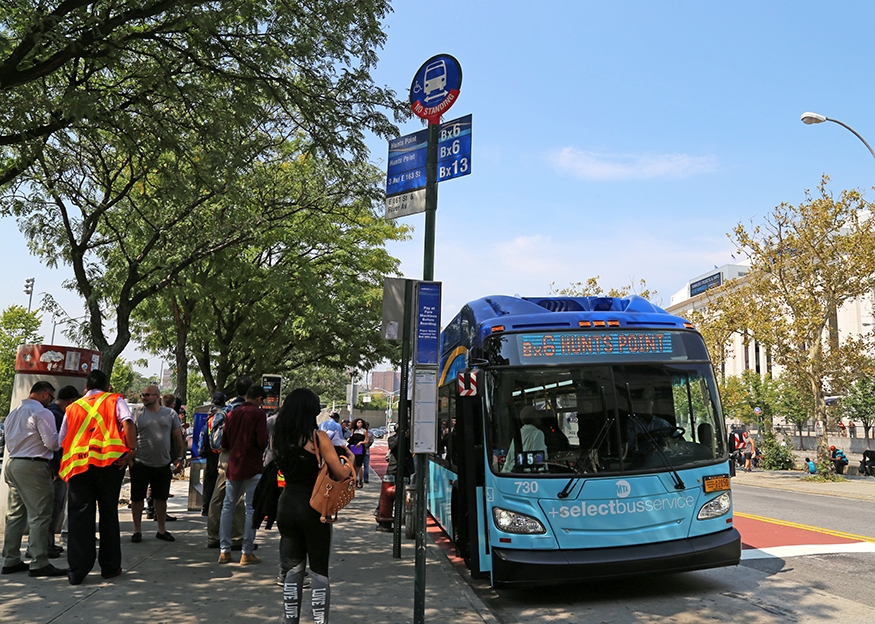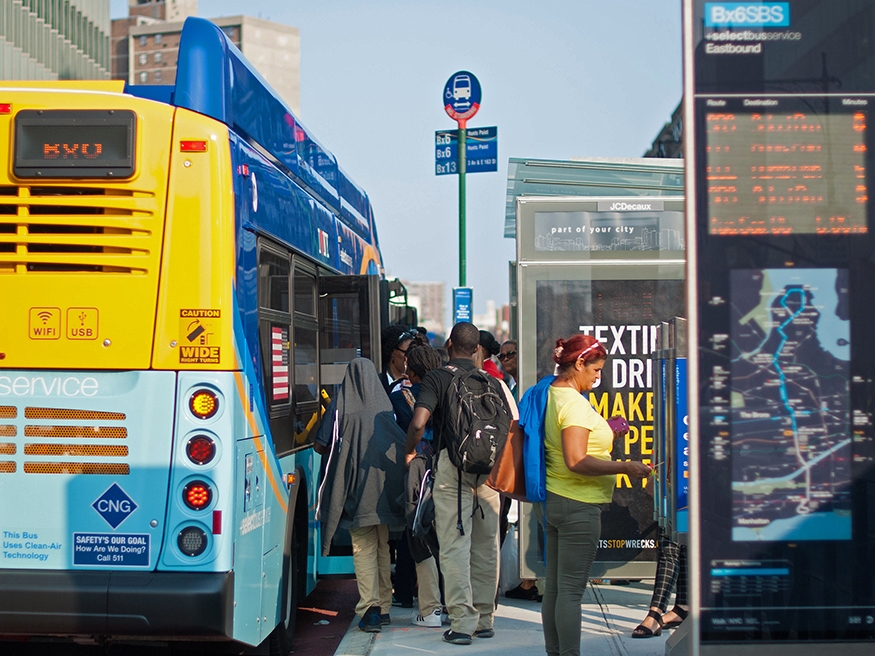Operational Project
Select Bus Service (SBS) is New York City’s bus rapid transit service, with 17 service routes located in all five boroughs. Designed in response to decreased bus speeds, SBS aims to create more reliable, expedient, and comfortable rides for customers. In the case of the South Bronx Crosstown Route, SBS enhancements significantly improved bus speeds and rider experience.

E 161st Street and River Avenue, Bronx

E 161st Street and Sherman Avenue, Bronx
Purpose
- Improve bus travel times and reliability, especially at key bottlenecks
- Enhance pedestrian safety
- Allow bus-curb access
Location
- Primarily on 161st Street and 163rd Street in the South Bronx, yet the full route connects Riverside Drive West in Washington Heights to the Hunts Point Market in Hunts Point
Context
- The Bx6 bus serves 24,000 daily riders as a critical crosstown route connecting to Manhattan, the Hunts Point markets, and eight subway lines
- 161st Street is a high volume street with mostly mixed-use land use and several major buildings, such as Yankee Stadium and a number of Bronx courthouses
- Prior to SBS implementation, cars often parked and double parked in front of bus stops and a nearby family court, preventing the bus from accessing the curb
- Narrow sidewalks along the corridor forced pedestrians to walk on the streets, creating dangerous pedestrian conditions
- Affordable housing currently in development along the corridor will further intensify the area’s transit needs
Project Origination
- After the success of Fordham Road and Webster Avenue SBS projects in the Bronx, MTA and DOT determined a need for a South Bronx Crosstown SBS route
- As a result of input from stakeholders, including the Bronx Borough President’s office, and on-street outreach with bus riders, the Bx6 was selected as the appropriate candidate due to need for improvements and opportunities for implementation
Planning and Design
- Through data analysis, DOT and MTA identified 161st Street from the Macombs Dam Bridge to Morris Avenue as a critical portion of the route due to high ridership and slow existing bus speeds. This section also included pedestrian safety and ADA issues, such as narrow sidewalks and street operations that blocked bus stop curb access in front of the courthouse. These challenges called for an unconventional and innovative design
- To address these issues, DOT considered creating a center-running busway starting at the Yankee Stadium Crosswalk, converting the tunnel under the Grand Concourse to bus-only, and constructing a pair of bus boarding islands in front of the courthouses. This design also allowed for sidewalk expansion between River Avenue and Gerard Avenue
- Subsequent traffic analysis revealed that a two-way bus tunnel would significantly impact traffic in the westbound direction
- After extensive outreach, featuring over 30 community meetings and events, DOT opted to balance the needs of community members and traffic concerns. The resulting design featured converting eastbound tunnel to bus-only while still allowing traffic in the westbound tunnel
- The center-running design with boarding islands helped mitigate the courthouse parking challenges
Implementation
- Implementation was conducted July-September 2017
- With a hard project deadline, the construction process required coordinating multiple parties at once
- DOT in-house teams poured bus boarding islands, while coordinating with MTA to install the bus shelters, fare machines, and SBS Wayfinding signs. Temporary materials were used for sidewalk expansions
Results
- Bx6 SBS route travel times are 11-16% faster than previous local service
- On 161st Street between Yankee Stadium and Melrose Avenue, Bx6 SBS travel times are between 32-46% faster eastbound (the direction with the bus-only tunnel) and 14-18% faster westbound than previous local service
- The Capital project will build upon existing successful transit improvements as well as address significant state of good repair needs along 161st Street

E 161st Street between Sherman Avenue and Morris Avenue, Bronx

